A Walk on the Withlacoochie State Trail

Mary and I took a late afternoon walk on the Withlacoochie State Trail, whose 46 miles run through Citrus, Hernando, and Pasco counties. Future plans include linking this paved trail to others in the region, making it part of the Central Florida Loop.
Up in Massachusetts we had bicycled and hiked along the Minuteman Bikeway, a rails-to-trails project extending 11 miles from Cambridge to Bedford. This trail is its Florida cognate, supported by Rails to Trails Of The Withlacoochee.
We entered through Holder, a small town about five miles up the road. (The South Citrus Springs trailhead is the closest entry point shown on the map.) Ahead of us was a beeline of asphalt, flanked by trees on the right and wide open spaces on the left.
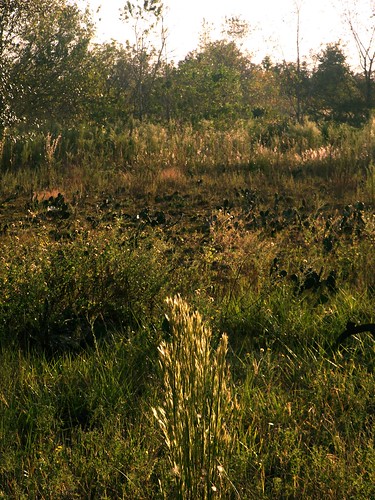
Foliage to the side of the trail (to our left on the outbound) catches late afternoon light.

Beauty berries (Callicarpa americana, Verbenaceae (verbena) Family) grew by the side of the trail. I've added watercolor effects to this original shot to enhance contrast.
"American beautyberry occurs naturally from Maryland, south to Florida, and southwesterly into Tennessee, Arkansas, and Texas," according to Floridata. "It also grows in Mexico, Bermuda, the Bahamas and Cuba. It inhabits relatively open, well drained, rich woodlands and dry hammocks....The colorful berries last long into winter and are eaten by a variety of birds."
We had started late and the trail remained relatively empty except for about a dozen bicyclists. This walk was meant to acquaint us with a feature close to home that we hadn't explored until now.
In-between the beautyberries, we came across dozens of golden silk spiders (Nephila clavipes, Family Nephilidae). Spaced evenly among the trees, their enormous orb webs looked like woven doors set to the side of a long asphalt hallway.
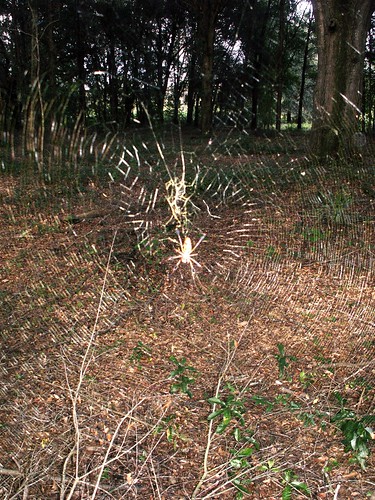
I've increased contrast to bring out the web, which takes up the entire frame of this shot.
Females of this species can grow to have a body (not counting legs) up to two inches long, and most of the spiders Mary and I saw seemed to be this size. Including legs, they were about as large as my hand. This shot from 2007 shows a female with a much smaller male.
One of the spiders on the trail was enjoying some dinner when we arrived.
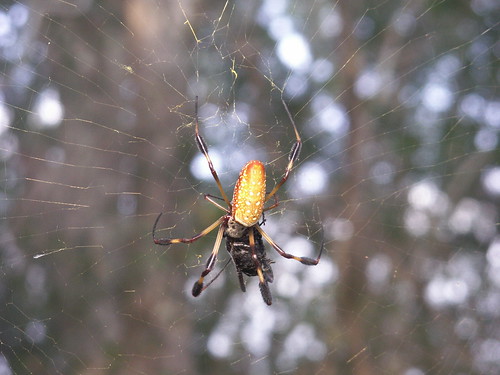
Large view
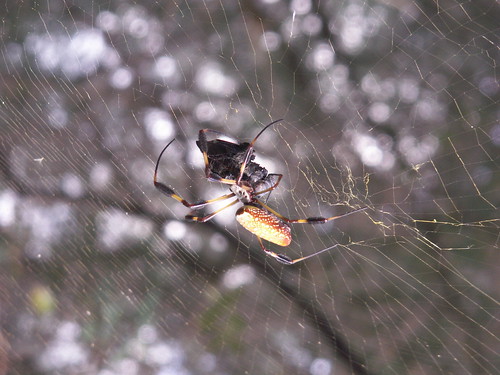
Large view
According to Bugguide, "This is the only Nephila species known in the Western Hemisphere. Other Nephila species are found in the south Pacific, SE Asia, Madagascar and Australia." The range is "Predominantly southeastern US. Florida, Gulf States, north to North Carolina, south to Central and South America as far as Argentina."
At home, several long-tailed skippers and a gulf fritillary were nectaring from lantana.
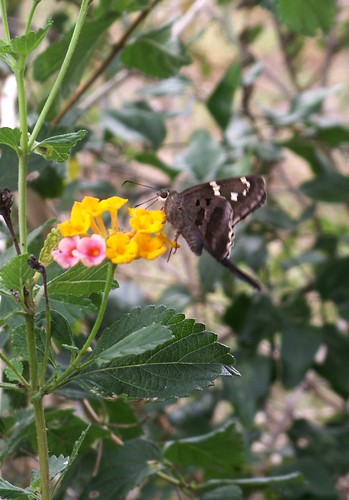
Large view
The long-tailed skipper (Urbanus proteus, Family Hesperiidae (Skippers)) ranges from "Argentina north through Central America, the West Indies, and Mexico to peninsular Florida and South Texas. Occasionally strays and colonizes north to Connecticut, southern Illinois, eastern Kansas, southern Arizona, and southern California," according to Bugguide. Skippers are a particular type of butterfly, characterized by "short fat bodies, hooked antennae and rapid, skipping flight." (Bugguide)
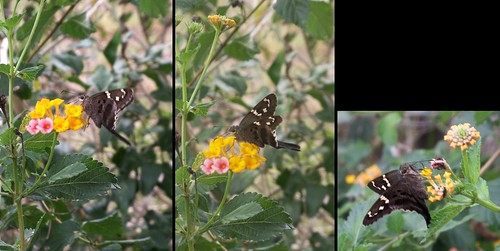
Large view
I frequently see gulf fritillaries (Agraulis vanillae, Family Nymphalidae (Brushfooted Butterflies); below) in the neighborhood. The species ranges mainly throughout the southern U.S., but strays northwards. Larvae feed on various species of passion flower, according to Bugguide.
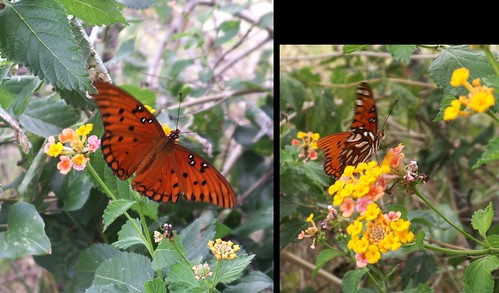
Large view
Like the beautyberry, lantana (Lantana camara), belongs to the Verbenaceae family. "Although common lantana is not native to Florida, it has been naturalized in the state for centuries," according to Floridata. Unripe berries and foliage are toxic to pets and livestock.
Our own lantana plant sprouted up around the snag of a cherry tree killed by lightning. Lantanas are butterfly favorites and the snag has become a popular hangout for dragonflies.
I put the trash out around 10 PM, and this little one followed me back inside:
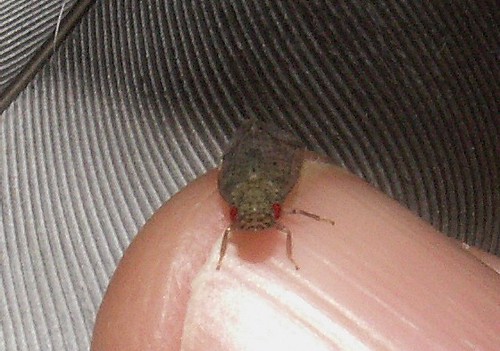
Here it perches on Mary's thumbnail, back-dropped by a pigeon feather. I was able to get in one decent shot before it grew restless and we escorted it out the door.
Entomologist Eric Eaton over at Bugguide suggested the Cixiidae Family, part of the Superfamily Fulgoroidea (Planthoppers), but pointed out that this shot didn't offer any conclusive data.
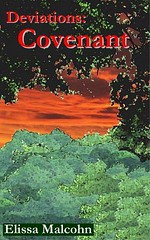 |  |
Vol. 2, Deviations: Appetite
Free downloads of both volumes here.
 | Go to Manybooks.net to access Covenant and Appetite in even more formats! |











2 Comments:
Thanks for the beautiful pictures and identified insects and flowers! Do you have more on a picture account that I can see? A treat for the eyes and brain!
We had fun painting ourselves with pokeberries last week.
The spider webs here especially sparkle.
Post a Comment
<< Home